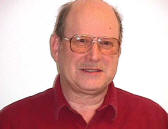Phillip Peters
Adams County Master Gardener
 Saying that a person is a gardener tells you two things: One - this person loves plants and has lots of them, and two - along with the plants there is an ever-growing collection of gardening books. Most rooms in the house, the
potting shed and basement all have their share. But there's always room for one or two more!
Saying that a person is a gardener tells you two things: One - this person loves plants and has lots of them, and two - along with the plants there is an ever-growing collection of gardening books. Most rooms in the house, the
potting shed and basement all have their share. But there's always room for one or two more!
You may have seen the recent PBS broadcast based on Michael Pollan's The Botany of Desire in which he takes the plant's point of view about how certain plants chose man to propagate them by appealing to our sensibilities. Pollan has written other very readable books that touch on the food chain and
the way we have come to use it in the world of agribusiness. In Omnivore's Dilemma he traces the food we put on the table for four different meals. He examines where the food comes from and the route it takes to our tables. In Defense of Food continues the look at the items we ingest every day and shows how radically they
differ from the foods many of us remember from childhood and, especially from those of our great-grandmother's day. His advice: "Eat healthy food. Eat in moderation. Plants should make up the main part of the meal." For a lighter read try Second Nature: A Gardener's Education, Pollan's account of his life in gardening.
Bernd Heinrich is a University of Vermont biology professor who possesses an encyclopedic knowledge of the flora and fauna of the North East. Three books focus on the life in the woods around his home in Maine: The Trees in my Forest, Winter World and Summer World. As he looks at the trees or the
plant and animal life during the hottest and the coldest seasons, he passes on a tremendous amount of information and very interesting tidbits that make the reader really appreciate the incredible complexity and endless wonder of the world we inhabit. His writing style is eminently readable and enjoyable. These are good
night stand books or, you can use them as textbooks and take notes. Seriously!
I often think I garden primarily to enjoy the insects that come to the garden. These three books are chock full of information and extraordinary photographs: Insects and Gardens by Eric Grissell is an excellent book that takes up the insects in our gardens. It is a very good introduction to garden
entomology. And you don't have to have a degree in biology to read it. It starts with a discussion of the orders of insects and progresses through insect development, survival techniques, feeding habits and reproduction to folklore and insect music. The goal is to encourage the gardener to appreciate the fascinating insect
world just outside his door. Carll Goodpasture's photography is a reason by itself to buy the book. The cover image of a crab spider stalking a sawfly should be enlarged and put on the wall!
Along the same lines is Douglas W. Tallamy's Bringing Nature Home. Chair of the Department of Entomology and Wildlife Ecology at the University of Delaware, Tallamy examines the relationships that abound in a garden. He, too, has the gift of making a very complex subject approachable. This book
takes a wider approach than the previous one and goes into the great variety of animals, birds, and insects that frequent our contrived little garden worlds.
Using a greater variety of native plants is not only advantageous from an ecological point of view, but will also attract more beneficial insects and animals to help plants thrive, minimizing our dependency on chemical sprays that manage harmful insects.
Native plants are accustomed to growing in our environment; therefore they can survive cold winters, killing frosts and hot, dry summers. Moreover, insects and animals in our neighborhoods have grown up with these plants. They can find ample food and reproduce among them while, at the same time,
protecting the plants from excessive predation and offering pollination services. The new hybrid plants are not part of the insect's history and, consequently, are not good partners in the garden ecosystem. Tallamy provides numerous tables and charts showing just what to plant to attract butterflies, for example. He also
has an excellent list of "Native Plants with Wildlife Value and Desirable Landscaping Attributes" - just the thing to help you decide what to plant in that bare space. Again, the photography is excellent.
And if you have questions about your perennials, or even if you don't, The Well-Tended Perennial Garden by Tracy DiSabato-Aust belongs on your bookshelf. There is a wealth of information about garden design, plant selection, planting, deadheading, pruning, etc. that you find very helpful. An
alphabetic listing of perennials gives detailed information on planting, maintaining and pruning a wide variety of the perennials found in our gardens today. Appendices cover ornamental grasses, perennials with specific maintenance requirements, and a schedule for planting and maintaining perennials.
Read these books over the winter and you'll approach next year's garden in an entirely new light with an unimaginable amount of knowledge. Enjoy!
Read other articles by Phillip Peters